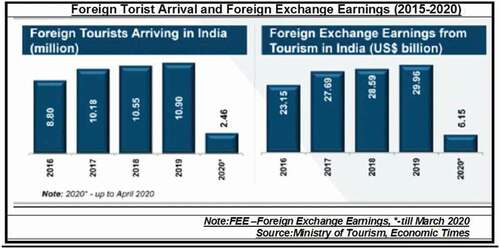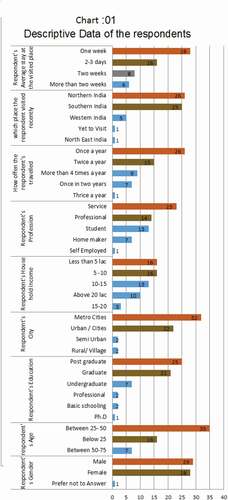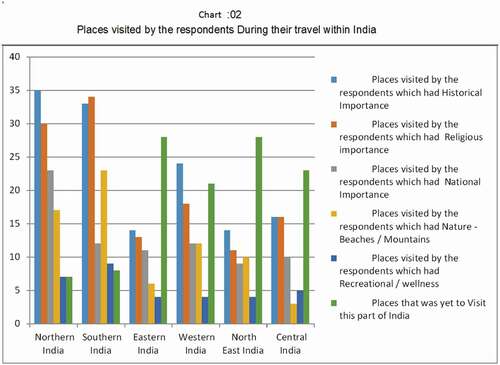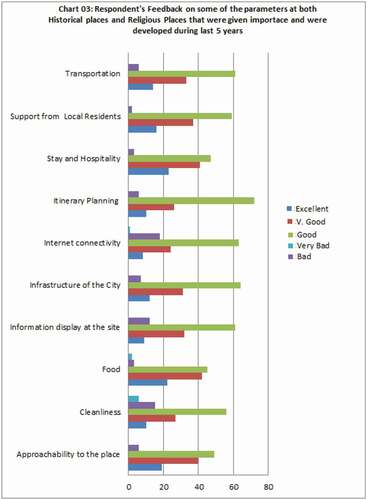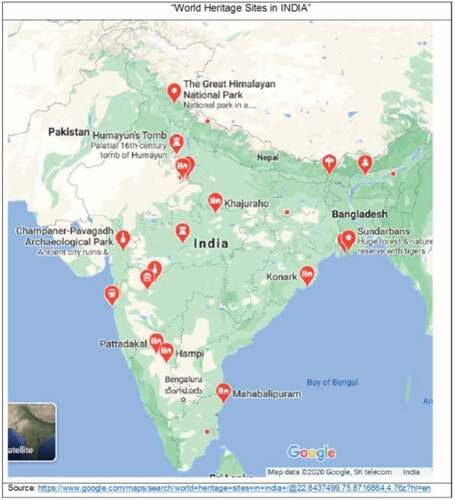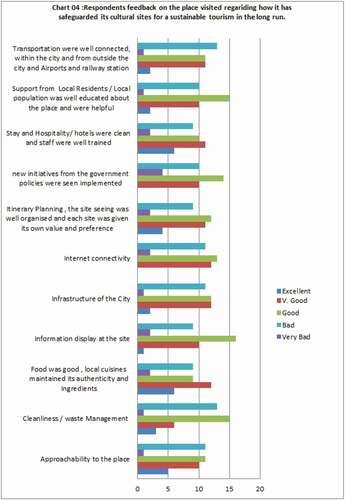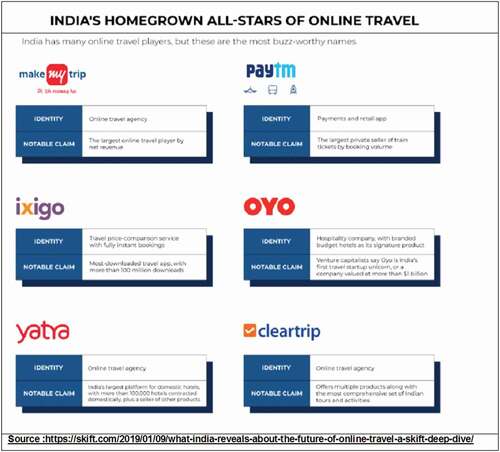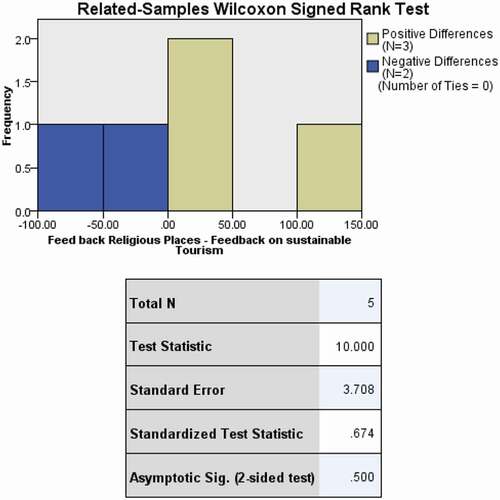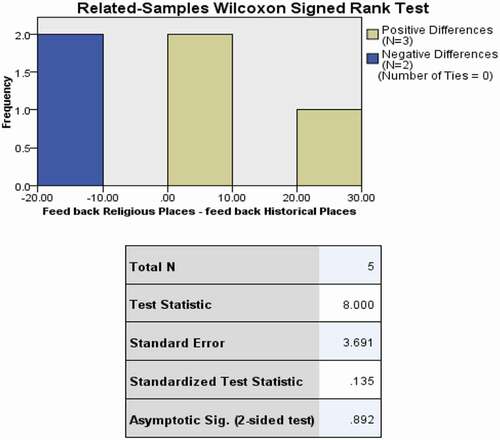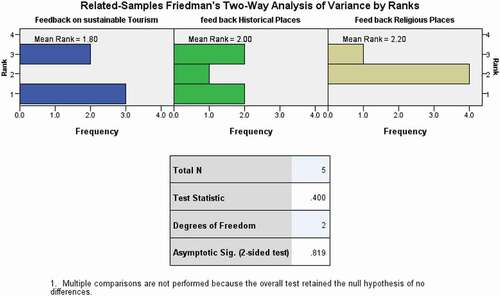Abstract
Culture can be defined as a way of life, a human value and the characteristic of the society and tourism is an activity that is undertaken to explore the above system. Cultural Tourism is a sector that focuses on those geographical areas of a country which reflect the art, architecture, religion and elements of that country. It includes showcasing the tradition, festivals and rituals they follow and how it influences the lives of the people living there. It also focuses on the richness and diversity. Travel industry is one among the pioneers to experience the taste of online presence in India. Online reservations started in the 1990’s with instant increase in the users exploring this option for their travel needs. The government of India initiated and facilitated train booking which was followed by the various airline operators. The efforts in restoring cultural sites, getting listed in UNESCO’s world heritage site, working towards the environment along with adopting modern digital platforms to facilitate its visitors are few highlights that can be understood. This paper tries to understand the stake of cultural tourism in India over other modes of tourism. How the share could be increased as India always vouched on its rich heritage and culture when it comes to Tourism, but still has not reached its potential output. How an online presence with active and interactive digitalization can sustain cultural tourism and increase its contribution. How the gap between the information provided and actual available resources could be matched for sustainability]
PUBLIC INTEREST STATEMENT
India was always a mysterious land for the outsiders, with a diversified natural wealth, mesmerizing landscapes and co-existence of people with multiple cultures and beliefs. Undoubtedly, developing sustainable tourism is one of the major steps that India looks forward to for economic development as one of the sources.
During the last couple of years, it has been found that major bottlenecks hampering the tourism sector have well been addressed and are being taken care of in a very appreciative manner. This paper intends highlighting a few such initiatives. This can help anyone who is planning their travel in the coming years to explore India.
The efforts in restoring cultural sites, getting listed in UNESCO’s world heritage site, working towards the environment along with adopting modern digital platforms to facilitate its visitors are few highlights that can be understood. This can also help the travel partners to understand the initiative of India and workout a systematic plan accordingly.
1. Introduction
Travel and tourism is the world's largest industry and generates 10.3% of global GDP and is estimated to reach 500 billion US Dollars by 2029. Over the past decade, this sector has not shown any sign of slowing down instead has grown as an important sector and a major contributor of foreign exchange (Kant, Citation2020). Unlike other sectors which can be defined under one clear category, it is extremely difficult to categorize tourism because of its incorporation, interdependence and interaction with many industries like lodging, transport, culture, and other business sectors. In the recent survey by Niti Aayog it has identified more than 500,000+ heritage sites and monuments in India and around 30 (of 38) cultural heritage sites are declared as World Heritage Sites by UNESCO, and approximately 3,691 monuments are taken under the custody of Archaeological Survey of India (ASI) and are declared as monuments of national importance (Niti Aayog, Citation2019).
Cultural tourism is one of the biggest attractions for the tourist and it is a known fact that many travelers who plan to visit India focus their trip on cultural tourism. And even if it is not solely for cultural; it is always a part of their package as a byproduct. We can always say that cultural tourism is always an unintentional part of every tourism destination. India with such a diversified cultural spot and a large treasure of cultural presence can create an unmatchable mark on the global destinations if handled and taken care properly. As a developing country India has already started making remarkable progress and creating an impressive impact, with a collaborative effort of all public and private to enhance all the sectors at the same time with due importance to each developmental plan. Further digitalization is also one of the major enhancements, which is creating a space for India on the global map. The sustainability of cultural tourism keeping in mind the new era of digitalization it is a challenge for a country like India to focus on both the ends and give fruitful results(Hardy, Beeton, & Pearson, Citation2010), (Katsoni, Vicky, Stratigea, Anastasia (Eds.), Citation2016),(Katsoni, Vicky, Segarra-Oña, Marival (Eds.), Citation2019). This paper will explore the initiatives that have been taken to make these two ends meet and create a new zone of sustainable tourism through retaining the cultural presence and digital transformation.
1.1. Literature review
“Cultural Tourism as a Business Model in India” by Raja Sarkar explores how cultural tourism can be a business model and analyses the challenges. It showcases that the tourist all over the world still continue to view India as a cultural tourism hub and hence India has a great potential to be a source of tourism growth.(Sarkar, Citation2018)
(Goh & Nagalingam, Citation2009) research work entitled “Sustaining Cultural Tourism Online: Video Documentary as a Digital Media Content” aims to establish the relationship between digital media and cultural tourism in the Malaysian context. It provides an insight on the tourism industry and its digital initiatives to transcend its culture. It illustrates the making of a video documentary and online product package to enhance cultural tourism and its sustainability in Penang.
“Success of Digitalization in Tourism Industry in India” by (Shigaonker, Citation2018) explores the concept of digitalization in travel & tourism, and how mobile, online travel portal and social media are creating an impact and further discusses the challenges faced by them.
Rathi in his work on tourism in 2018 (Rathi, Citation2018) titled “Digital Transformation of Travel & Tourism in India” explores how technology is a driving factor for the travel industry. He goes on to discuss how Artificial Intelligence (AI), Big Data, mobile applications, social media and Virtual Augmented Reality have become a normal accepted term in this sector and how the customers are benefited by it.
Improving heritage management in India, a working group under the chairmanship of CEO, NITI Aayog has been created by the Prime Minister’s Office (Niti Aayog, Citation2019) is a comprehensive summary of work done, planned to protect and preserve natural heritage of India, and develop possibilities of enhancing tourism and sustainable cultural heritage .
L.A.Koziol, R.W.Pyrek in their paper “The Concept of classification of Tourist Motivation Factors” present their general view on the motivational factors that influence Tourism, and how these factors can lead to the development of such places as tourism destinations.(Koziol & Pyrek, Citation2014)
2. Background of the study
2.1. Journey of Indian tourism and its cultural sustainability to the future
With a very appropriate quote regarding India by one of a famous German scholar “If I were to look over the whole world to find out the country most richly endowed with all the wealth, power, and beauty that nature can bestow—in some parts a very paradise on earth—I should point to India” by Max Muller, we could not agree less.
India is a land of diversified culture, finest architectural heritage, remarkable landscapes and spectacular beaches and mesmerizing mountain ranges. Indian peninsula is categorized into four regions, Mountain Zone, Plains of Ganga and Indus, desert region and southern peninsula. With a total area of 32, 87,263 sq. km, this extends from the snow-covered Himalaya to the tropical rain forests down south. Being the seventh largest country in the world, India has a very unique presence and existence from other countries. India offers a vast range of tourism choices, with diversified culture, heritage, tribes, cuisine, faiths, art and craft, land and nature, people, adventure, sport, spirituality, history to name a few. It is surprising that one can experience the change in culture within 50 km distance.
2.2. Evolution of tourism sector in India
The very first step towards sustainable tourism was through National Tourism Policy in 1982, when the then government formulated a comprehensive plan in 1988 to promote tourism. By the year 2000 major states in India declared tourism as an industry and its contribution as a part of the development parameter. It promoted private—public partnership in this sector and established sustainable hotel industries. New national policy on tourism was announced in 2002, focusing on developing a robust infrastructure and coexistence of multiple sectors for economic growth (tourism.gov.in), (incredible India tourism, Citation2020). This was the time when online travel portals & low-cost carrier airlines were introduced and gave a boost to domestic tourism. Since 2015, the government has introduced various schemes and marketing strategies to promote this sector and generated employment opportunities .
The latest draft of the new National Tourism Policy has been approved which includes ten strategic pillars as shown in Figure: The policy ensures visits and revisits of tourists and exclusively promotes domestic tourism. Apart from the general reasons of visiting interventions for cultural sites along with medical & wellness, Business, Adventure, Wildlife and so on are also induced. The policy plans to develop core infrastructure (airways, railways, roadways, waterways, etc.) (Baken & Bhagavatula, Citation2010).
2.3. Growth drivers for cultural sustainable tourism and digital transformations
India is one of the very few countries which enjoys such a diversified Culture, weather, geographical presence. If we go with the facts, India’s tourism Industry is the third largest foreign exchange earner after garments, jewelry and gems. India’s contribution towards travel and tourism GDP stands as the eighth largest in the world. Being one of the largest service industries, tourism is an integral part of Make in India initiative.
In the year 2018, the total number of domestic tourist visits within the states and Union Territories stood at 1854.93 mn with an annual growth rate of 11.9%. Further, as a value addition to this India registered 10.90 mn Foreign Tourist Arrivals (FTAs) in 2019, registering an annual growth of 3.2%. This upward trend also indicates that nowadays travellers are interested in numerous shorter holidays throughout the year, which is again a driving force for travel products and services throughout the year. The five year comparative data can be visualized in
The World Heritage List has identified around 30 cultural sites under its listing (). There are 3,691 monuments/sites under the protection of the Archaeological Survey of India. UNESCO has always emphasized that no development can be a sustainable development if it lacks Cultural components. Further, to ensure that retention of culture to be an integral part of all sustainable development policy hence started promoting cultural diversity. In India, some of the prominently identified sites are: The Taj Mahal at Agra, The Jantar Mantar at Jaipur, and Group of monuments at Mahabalipuram, Rani-ki-Vav (the Queen’s Stepwell) at Patan, Gujarat and latest to the list is the Jaipur city to the list. The Fig:02 shows the world heritage sites in India.
The Indian government in the last few years is constantly investing in infrastructural development and are developing better roads and other means of transport, clean and hygienic stay, which is a major factor for boosting tourism.
At the Digital front, again India is one of the potential hubs for digital databases with a significant consumer base and is continuously generating a huge amount of data every day. Many hospitality players, stakeholders are eager to invest in India with the latest technology and better consumer mapping. Technology-driven site search, booking of tickets, check-ins, biometric-based validation are other potential upgradation of digital infrastructure which are again a course of customer satisfaction. These, on the other hand, are creating digital revolution and automating the tasks creating new job opportunities and advanced skill implementation in interdependent sectors.
2.4. Challenges to the growth cultural sustainable tourism and digital transformations
Being such an expanded country in the world it is difficult to initiate new policies and implement a new system. Many initiatives are taken by the Indian government, still face the challenge of inadequate infrastructural constraints. The regular flow of funding along with the time framed managed development are constantly disturbed.
The safety and security of tourists, both domestic and the international, is also an important aspect that the government must undertake and work towards it. The vast population and a diversified culture will not sustain for long with people and the tourists visiting to explore the places and have security issues. It also includes that many rural places which are rich with cultural bliss often lack basic amenities like good hotel/home stay, hygienic toilets & cafeteria, better food experience etc (ibef Reports).
While most of the heritage sites and places of cultural prominence lie in the semi-urban and areas away from the big cities, internet connectivity and slower network access creates difficulty for the traveller to use online support to book their travels (). Moreover, low technological awareness and available information online limits the accessibility to access online resources. This, by and large, creates a lack of trust thus discouraging online transactions and use of plastic money, e-wallet and online payments in India. According to 2017 figures from the World Bank, only 3% of India’s population use credit card and is ranked 111 on a list of 141 countries for credit card penetration.
Many visitors to India find the e-visa facility a cumbersome one mainly due to lack of awareness about the new e-visa policies and govt initiatives for the quick processing ().
Table 1. Descriptive data
Table 2. Places visited by the respondents During their travel within India
Table 3. Respondent’s Feedback on some of the parameters that were given importace and were developed during last 5 years
Table 4. Respondents Feedback on the place visited regariding how it has safeguarded its cultural sites for a sustainable tourism in the long run
3. Research methodology
Through this study, the researchers attempt to answer the following research question:
RQ: How can India sustain the concept of cultural tourism and increase its contribution with strong online presence and highly interactive digitalization?
In order to answer the above Research question, the following objectives are being framed:
O1: To identify the stake of cultural tourism in India over other modes of Tourism option and how it could be increased.
O2: To assess and identify the factors influencing the tourists preference for cultural tourism.
O3: To identify sustainable measures to bridge the gap between the tourists perception of available and actual resources.
O4: To assess the challenges in fulfilling the expectations of tourists.
The following Hypothesis is identified for this study
H01.There is no change or difference between feedback received from the respondent on sustainable tourism and religious places.
H02. There is no change/differences between feedback for historical places and feedback for religious places.
H03.Feedback on sustainable tourism, feedback on historical Places and feedback on religious places were considered and was found that this also gave a similar response.
The researcher, for this study, has divided the country into six zones, namely northern India, southern India, eastern India, western India, northeast & central India. Data analysis has been performed on the primary data collected using the questionnaire from the travelers who travelled in these zones during the period of the study, i.e. 2015 to 2019. For the result analysis various statistical tools like ANOVA (Friedman’s Two-Way Analysis of Variance by Ranks), Pearson Correlation, Wilcoxon Signed Rank Test were used.
The secondary data are extensively collected from various government tourism reports, portals, books and authentic online resources like the Ministry of Tourism, Ministry of Culture etc.
3.1. Limitation
In a country like India with a very diversified cultural base considering every cultural spot for this research was not possible, it has been found on records of Government of India and Ministry of Tourism in their initial survey that they have identified more than 400,000 heritage structures across the country inclusive of the centrally protected and state protected monuments, heritage buildings under various religious trusts, historic cities and archaeological sites. Unlike other nations, India’s cultural heritage shows continuity since centuries and are age-old traditions practiced. It is very difficult to analysis and evaluate all or even many of them. Hence, an overall average reports and overall response of the respondent were considered who visited mostly the popular destinations.
Further, the parameters for measuring the sustainable development and sustainable cultural tourism are very large in number; hence, only the major space where the government of India has launched many renovative and innovative schemes are considered for this research paper.
Due to pandemic, for this research purpose, the physical verification of records and footfall at actual destinations could not be collected; however, the secondary data available online were considered from the Government and reliable sources.
3.2. Data analysis and findings
The data collected were broadly categorised into three major parts; the first part was a brief description of the respondent’s demographic profile, which had basic details of the travellers and how they are connected and interested in travelling. Chart:01 shows that the respondents in the age group of 25–50 years were interested in exploring the cultural diversity of the country (India). The primary data suggests that responses of male and female respondents are the same. Though the income is not the major influencer for the tourist, however indicates that the people with higher income are more liberal in spending for travel. Most respondents belong to the metros and travel atleast once a year.
The respondents travelling within India at one time or another mostly visit places of historical importance or religious importance, depicting Indian culture. It further reflects that even if the initial planning of the trip is not focused on cultural tourism, and most of them did not have cultural tourism as their primary requirement, but ended up visiting places with religion-connect and/or culture-connect.
Chart:02 categories the places the visitors’ visited during their travel, for understanding it better the entire India was broadly divided in different zones. Interestingly, it indicated the most visited places were northern and southern parts of India. In that too the major influences were the places with religious and historical importance. It further explains that the eastern, western, north east and central India are yet to be explored, however even in these places the visitors to historic and religious places are high as compared to other categories like Places with national importance, Beaches and Wellness points etc.
Being a developing country, India is also working towards the overall infrastructural development and interdisciplinary contributions of different sectors towards economic growth. This study further tries to Explore the parameters on which current developments are based like cleanliness, development of basic Infrastructure, hygienic stay, frequency of the transportation to any such tourist-centric location connectivity of roads for better commute, better internet connectivity, access and speed, etc. it was found that the visitors considered these parameters as well which majorly influence the choice of selection of the place to visit .
Moreover, parameters like approachability, infrastructure of the city, support of local residents, cleanliness, transportation, stay and hospitality, food, itinerary planning, information display at the site, and internet connectivity, etc have a visible scope for improvement as per the response shared by the respondents, but they did not deny that the considerable efforts were done by the government to make the facilities at par. The scope of improvement still exists; however, with frequent changes to the system it is difficult in keeping pace with technological upgradation and seems to be challenging. This opens the scope of further study on these parameters in specific.
The survey response from the respondent in their feedback on sustainability show a positive outcome on the following parameters like approachability to the place during the last few years, infrastructure of the city, support from local residents and awareness among the local population about the place and its cultural importance, cleanliness and waste management, connectivity of Airports and railway station, stay and hospitality, food quality and local cuisines, itinerary planning of the sightseeing, etc. Almost all the respondents felt that these were well organized and each site was given its own value and preference and the information display system at the site were also very clear and relevant to the site, further on the digital ground initiative to ease the internet connectivity, online support and information system and e-visa processing everything was streamlined in the recent years and the same is reflecting in the responses from the respondents .
This study tries to find out whether the development initiatives for promotion and support to cultural tourism are sufficient and are on the progressive path. It was found that the developmental initiatives had a positive impact on the tourist and is certainly a sustainable solution for the economic development as well as the tourism sector. New initiatives from the Indian government, updated policies, private public coordination to sustainable development were seen to be implemented. Digitalisation and online presence were also notably visible in recent government initiatives.
The feedback of respondents on sustainable tourism, religious places as well as on historical places were also considered, studied and classified as these can broadly be classified as the components of cultural tourism.
Below is the summarized report of three parameters on which the correlation were tested and it was found that every parameter that was tested gave a significant result and was about 0.01 level (2-tailed).
The correlation between respondents’ feedback on religious importance places and sustainable tourism was calculated
3.3. Hypothesis test summary
H01:There is no significant difference between feedback on Sustainable Tourism and feedback on religious places.
Hence, H01 is accepted and there is no significant difference between feedback on Sustainable Tourism and feedback on religious places. It is a clear indication that the parameters of sustainable tourism have matched to a large extent with the facilities in religious places.
H02:There is no significant difference between feedback historical places and feedback religious places
Hence H02 is accepted and it is proved that there is no significant difference between feedback historical places and feedback religious places. In both historical and religious places, the respondents found them to be at par with their expectations.
H03:There is no significant difference between the feedback on sustainable tourism, feedback on historical and religious places.
Hence, H03 is accepted. It is observed and validated that there is no significant difference between the feedback on sustainable tourism, feedback on historical and religious places.
Thus, all the three hypotheses were accepted; however, they indicate that a positive correlation exists between the given parameters and that improvement and upgradation in parameters would necessarily positively affect sustainability and thus contribute to the tourism ecosystem.
4. Conclusions
This paper summarizes the tourism sectors that influence the Indian Economy and its sustainable development goals. The identity of India in general terms may be defined as a place which has a very rich cultural presence as with every 50 km distance one can experience a different and vibrant culture. Hence, first, through this paper, our findings show that the stake of cultural tourism over other modes of tourism is comparatively high in India. The government of India is also planning to boost such cultural tourism themes as it supports sustainable goals. Further, this paper supported with a survey identified the major factors that are influencing the tourists to prefer cultural tourism and how the Government of India’s initiatives are supporting it. It also summarises the gap between the perception of the visitor and the actual available resources. It also elaborates the sustainable measures to bridge the same. Finally, this research paper identifies the challenges in fulfilling the expectations of tourists and how digitalisation is supporting the same and leading Indian tourism towards a sustainable path.
The survey results show that with the current findings and reports it is visibly clear that cultural tourism is the way to move to have sustainable stability in the tourism sector. We can further say that since, Post-Independence Tourism has always remained an important part of India’s Five Year Plans for development. Domestic travelers as well as foreign travelers’ demographic profile has changed during the last few years so is the frequency in which they prefer to travel. Development in this sector has an influence in enhancing the standard of living of the residents and also creating livelihood opportunities for them. More and more visitors push the infrastructural development, further as the uniqueness of the site has to be effectively communicated the initiatives taken online are also contributing to it.
Tourist spots which are appreciated globally bring cultural pride among the people living around and created a unique space for India on the global map of tourism. However, as the gap can still be visible and hence it gives a scope of further improvement and establishments in this sector.
The parameters are huge; however, the outcome shows a positive and progressive result on many of the parameters, it further opens a way for future study in this topic and explores more valuable feedback. Based on the respondents’ demographics, it is seen that scribes that as now a day’s not only the older generation who were basically the mass travellers to any such cultural sites in India, but young tourists within the category of 25 years to 45 years are interested in taking such cultural travel options over other available themes. Also, this shows that not like earlier when the trend use to be like the travelling was only taken at the later stage of once life for e.g., after the retirements are planned, but with the promotional initiatives its show that more and more young travellers are interested in exploring the India and enjoy short visits throughout the year to all the nearby approachable destinations mostly to enjoy the traditional and cultural treat of that site.
Additional information
Funding
Notes on contributors
Sreelekha Menon
Sreelekha Menon is a Research Scholar at SRM Institute of Science and Technology, India. She is doing her research in eCommerce and its impact on Indian businesses. She has more than 15 years of corporate experience in strategy planning and Business Development.
Swati Bhatt
Swati Bhatt is an Assistant Professor (Marketing and Strategy) at SRM Institute of Science and Technology, India. She has more than 20 years of experience in training and academics. She is an expert in Marketing, Strategy, Sustainability and Entrepreneurship. She has participated and presented her research work in many conferences and journals.
Sharat Sharma
Sharat Sharma is an Assistant Professor (Finance and Quantitative Techniques) at SRM Institute of Science and Technology, India. His expertise is in Finance, Business Statistics & International business. He has more than 20 years of experience in research and academics. He has authored many books on Business Statistics and has publications in international conferences & journals.
References
- Anne Hardy, R. J. (2010). Sustainable tourism: An overview of the concept and its position in relation to conceptualisations of tourism. Journal of Sustainable Tourism, 475–496Anne Hardy, Robert J. S. Beeton & Leonie Pearson (2002) Sustainable Tourism: An Overview of the Concept and its Position in Relation to Conceptualisations of Tourism, Journal of Sustainable Tourism, 10:6, 475-496. https://doi.org/10.1080/09669580208667183
- Baken, Robert and Bhagavatula, Suresh, Some Reflections on Tourism and Tourism Policy in India (December 21, 2010). IIM Bangalore Research Paper No. 320.https://doi.org/10.2139/ssrn.2122440
- For tourism, here is an Incredible India 2.0 plan. (2020). Retrieved September 5, 2020, from https://www.hindustantimes.com/analysis/for-tourism-here-is-an-incredible-india-2-0-plan/story-Nu3zhLsyeFzjEW1FK4QUpK.html
- Goh, C. H., & Nagalingam, S. (2009). Sustaining cultural tourism online: Video documentary as a digital media content. Proceedings of 2nd National Symposium on Tourism Research. Malaysia: Universiti Sains.
- Improving-heritagemanagement-in-India. (2019). Retrieved June 2020, from https://niti.gov.in/sites/default/files/2020-06/Improving-HeritageManagement-in-India.pdf
- Incredible India Tourism. (2020). Retrieved July 15, 2020, from incredibleindia-tourism.org: http://www.incredibleindia-tourism.org/
- Indian-tourism-and-hospitality-industry-analysis-presentation. (n.d.). Retrieved August 30, 2020, from https://www.ibef.org/industry/indian-tourism-and-hospitality-industry-analysis-presentation
- India-tourism. (2020). Retrieved September 5, 2020, from incredibleindia-tourism.org: http://www.incredibleindia-tourism.org/india-tourism.html
- Koziol, L., & Pyrek, R. (2014). The concept of classification of tourist motivation factors. In V. Katsoni (Ed.), Cultural Tourism in a Digital Era (pp. 57–19). Springer International Publishing.
- Niti Aayog. (2019, June 11). Improving heritage management in India. https://niti.gov.in/sites/default/files/2020-06/Improving-HeritageManagement-in-India.pdf
- Rathi, R. A. (2018). Digital transformation of travel & tourism in India. International Journal of Trend in Scientific Research and Development (IJTSRD), Special Issue( special issue-ICDEBI2018), 64–69. https://doi.org/10.31142/ijtsrd18673
- Sarkar, R. (2018). Cultural tourism as a business model in India. International Conference on Indian Trade & Commerce: Past, Present & Future. Bhubaneswar, Odisha, India.
- Shigaonker, S. A. (2018). Success of digitalisation in tourism industry in India. International Journal of Trend in Scientific Research and Development (IJTSRD), Special Issue( Special Issue-ICDEBI2018), 217–220. https://doi.org/10.31142/ijtsrd18708
- TourismInfrastructure development. (n.d.). Ministry of Tourism - Government of India. Retrieved August 20, 2020, from http://tourism.gov.in/tourism-infrastructure-development
- Vicky, K., & D, A. (2016). Tourism and culture in the age of innovation. D. V. Katsoni. Springer Proceedings in Business and Economics.
- Vicky, K., & Segarra-Oña, M. (2019). Smart tourism as a driver for culture and sustainability. Springer.

